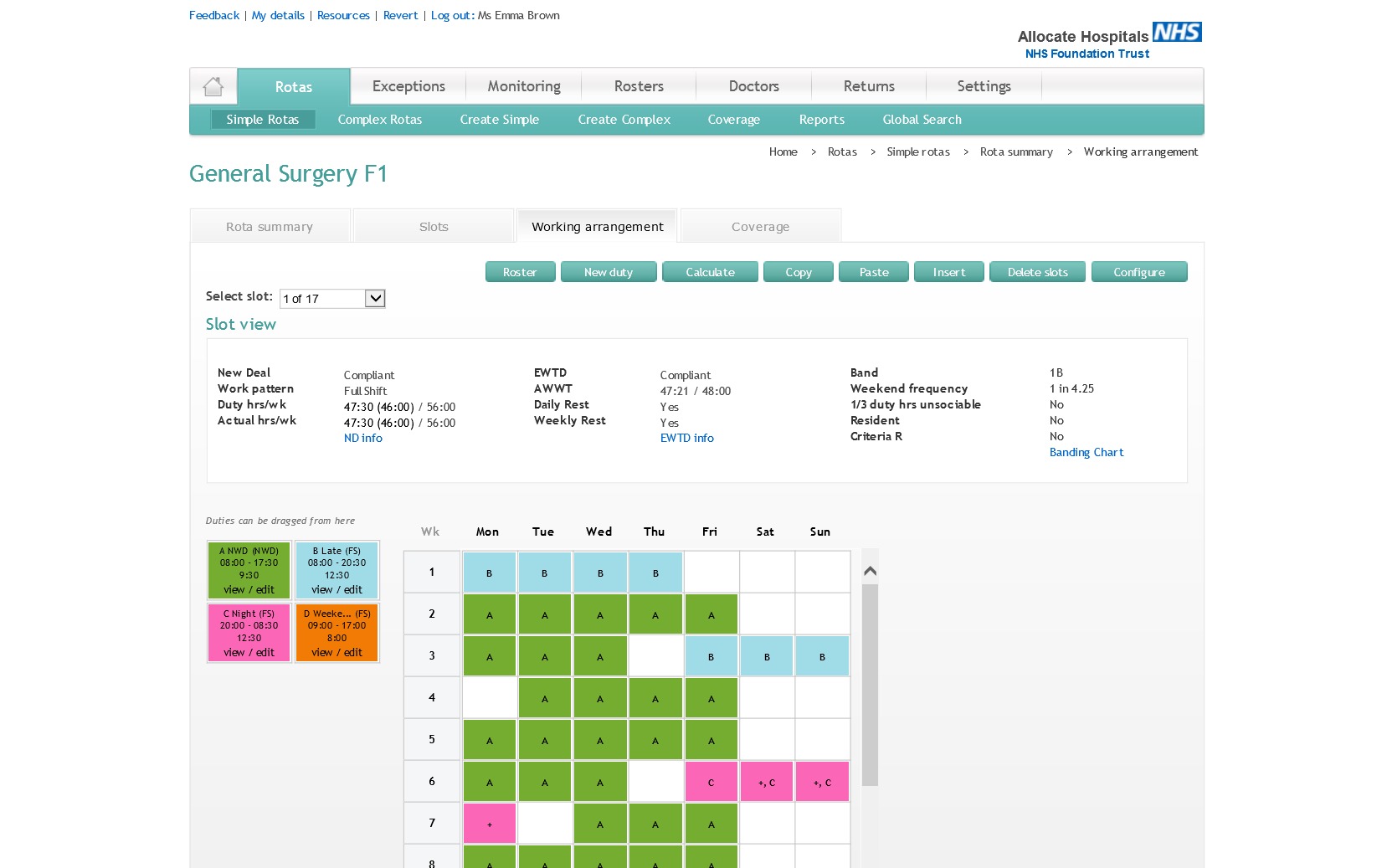“I have a roster so why do I need a rota?” says Jack the roster manager to medical staff manager Joan who in turn replies “I am not too bothered about your roster as long it does not make my rota non-compliant”.
This is a common and often repeated discussion between two key players in the effective scheduling and resourcing of junior doctors across the NHS.
In reality these two terms could easily be interchanged, but that’s not helpful because they mean different things to different people depending on who you are talking to across the Organisation. To make matters worse many vendors cloud the issue even further by using one term to describe themselves and their activities, whilst providing exactly the opposite.
In the global community, a rota and roster are generally accepted to be the same thing. However in a world of European Working Time Directive (EWTD), New Deal contracts and now 2016 contracts governing junior doctor working patterns, the differentiation is important to begin demystifying the haze. SO…
A rota is the pattern of shift work which has no individuals attached to it . It has been designed to form a blue print of compliant or rules based working patterns for a department, team or unit.
A junior doctor rota is normally where this planned pattern of work is tested to ensure it is complaint to EWTD, New Deal and 2016 contractual requirements. Once satisfied, the rota which has slots based on each post to be filled, and cycles over the number of weeks that the rota is expected to run, becomes a roster by simply adding the actual names of the doctors who will fill those posts into each slot.
A roster is also affected by real time events such as absence (planned or unplanned), on call commitments, and the actual demands of the department / team on the day.
This is primarily one of the key reasons why a roster tends to become out of step with a rota, and also why non-compliance is always a close friend of a roster.
None of these daily challenges affects a rota, which remains a blueprint or the ideal working pattern for the team (even with prospective cover (New Deal) and allowance for leave (2016) built in to the rota).
For the cynical reader who still does not understand why this is necessary in the first place, imagine this simple rota becoming a roster with the added complexity of two part time doctors sharing one of the slots as well as half of the doctors rotating out of the roster halfway through and another set of doctors rotating into those same slots.
To maintain compliance whilst managing the available resources becomes a tricky and a very expensive experiment if a Trust gets it wrong, with the wrath of Band 3 claim under New Deal or an exception report under 2016 contractual requirements lurking just around the corner. Both penalties could be financially burdensome on a Trust’s finances.
Many organisations have increasingly been under the impression that once they have a good rostering solution there is no need to build a compliant rota. This is in fact quite far from reality.
In the world of New Deal, there remains a statutory obligation for a Trust to initially build a compliant rota meeting both EWTD and New Deal requirements. This rota is then monitored twice a year at a minimum to ensure it maintains compliance based on the actual log of the junior doctors’ work patterns, on that particular roster (minimum two-week monitoring period). You are perhaps quite sharp if you have already spotted the anomaly in this approach. This process means that you were monitoring a roster to see if a rota was still compliant.
The rota once built will not change and of course it is still compliant, but this process tested whether it was fit for purpose in terms of meeting the actual requirements of the department / team that it was designed for in the first place.
Naturally this exercise also largely drove the whole process of rota bandings for payment as well.
In the new world of 2016 contracts for junior doctors, there are no such monitoring requirements, but there is a process for doctors to report exceptions which enables continual monitoring process throughout the year should there be any deviations from the planned rota.
Under the 2016 requirements a Trust is required to provide a junior doctor with a work schedule prior to commencing work which of course will come from a slot on a planned rota long before it even becomes a roster.
As the requirements of medical rostering becomes even more complicated, one thing remains clear – that without the strong foundation of a compliant rota to build an effective roster in the first place, Organisations will find life becoming increasingly complicated and expensive in the long term as non-compliance becomes common place in an environment where even more is being demanded with less.
It also takes us full circle to the understanding that the journey of effective medical rostering always should provide the opportunity to fine tune today to make a better tomorrow, i.e. the ability to compare the actual work (roster) to the planned work (rota)
Check out Allocate’s HealthMedics solutions to find out how eRota can help you build compliant rotas.

Mike Sealy has a varied international background, having been born in the Caribbean, he has worked across the entire chain of English speaking Caribbean islands as well as the Bahamas as an IT consultant in the Insurance and banking sector. Mike migrated to the UK in 2002, mainly to complete his Master of Science in International Marketing Management , and joined Zircadian limited in March 2007 having previously worked as an infrastructure specialist in London. He took over the role as Sales Manager for the organisation with remarkable success for the next 5 years and moved into the role of National Sales Manager for medics after the acquisition of Zircadian by Allocate Software. Mike subsequently took on increasingly strategic responsibility as the focus of medics grew with Allocate and was promoted to Director Health Medics October 2015 where along with strategic responsibility for the development of the entire medics portfolio, he also manages a specialist medics sales team for the UK.





